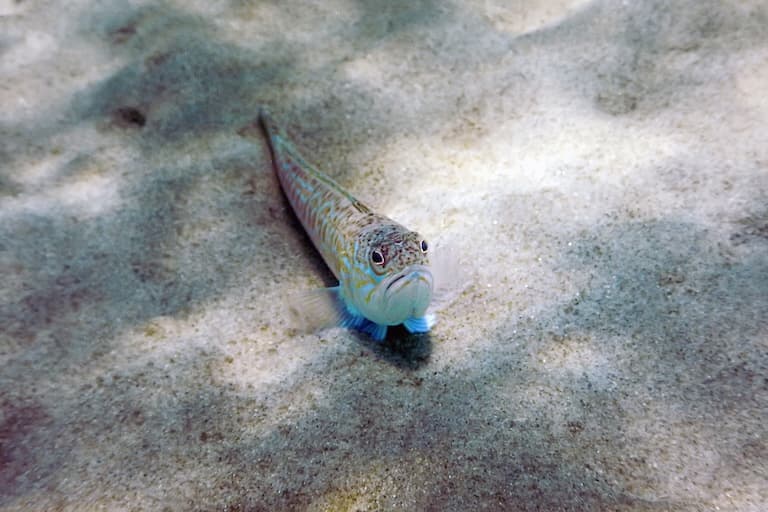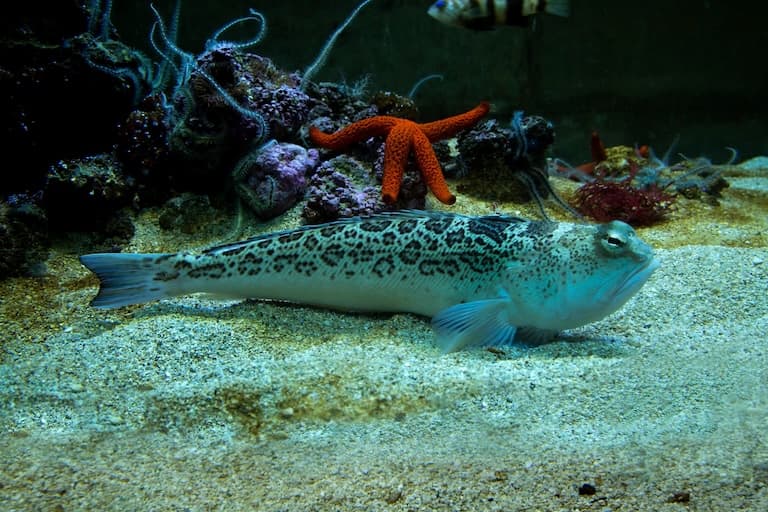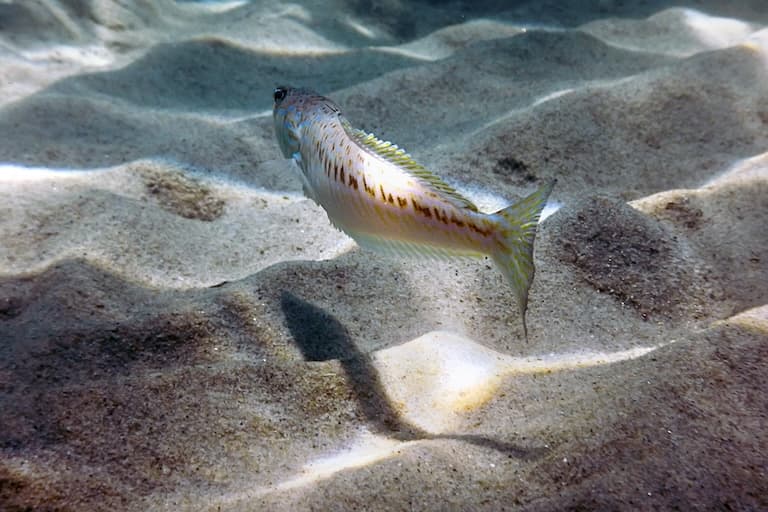Weeverfish Profile
Britain is a hostile place for wildlife, which is why so many natives are afraid of moths, and an embarrassing number drop dead from shock when in the presence of a wasp.
So, “The UK’s Most Venomous Fish” is a title that belongs in a special book that nobody would buy, along with “Spain’s most frightening avocado” and “Ed Sheeran’s most musically intriguing work”. This is why, if you combine the sting of a wasp with an invisible marine predator, you will undoubtedly get hysterics.
The weever is now the most terrifying creature to inhabit the ‘Isles since the extinction of the Great Auk, but could it be worthy of the hype?

Weeverfish Facts Overview
| Trait | Description |
|---|---|
| Habitat | Coastal waters |
| Location | From the North Sea to the Mediterranean, down the West coast of Africa |
| Lifespan | Unknown |
| Size | Up to 53 cm (21 in) long |
| Weight | Not listed |
| Colour | Brown, light to dark, usually spotted or mottled |
| Diet | Shrimp and small fish |
| Predators | Grey seals, humans |
| Top Speed | Slow |
| No. of Species | 9, in two genera |
| Conservation | Least Concern (IUCN) |
Like the photographers at Maxim, weeverfish love a sandy bottom, and like many of its readers, they’re covertly predatory creatures, hiding in the muck, instinctively lunging at anything juicy passing their way.
This is where people get into trouble: weevers have venomous dorsal spines capable of delivering a painful sting.
Some say it’s similar to a wasp sting, while others need to be airlifted in agony.
Unfortunately, a cure for cowardice has yet to be discovered.
Interesting Weeverfish Facts
1. They’re named after snakes
This is an interesting one, since the name might suggest a more likely association with the deeply
seraphic and venerable Sigourney, or those guys who cut through traffic on motorcycles, but it’s got a
much cleverer literary origin than these.
The name comes from the old French word wivre, which used to mean serpent, and while this isn’t an instantly familiar root, that word descends from the Latin vipera, which most definitely is.
Give or take the occasional tiger shark, the shallow ocean appears to be a tranquil and idyllic place for
large, terrestrial mammals, but for local small, swimmy things, it’s a terrifying gauntlet of
subterranean death gulpers, the weevers being one of them.
Weevers all share the common trait of burying themselves in the sand, their little beady eyes poking
up through the substrate, waiting for a hapless shrimp or fish to pass close enough before lunging out and grabbing it.
While weeverfish look nothing like snakes, the similarities become immediately obvious if you ever
step on one.

2. They can sting
Greater weevers tend to prefer deeper waters, far from the pasty, lotioned feet of the British
beachgoers, but other species, such as the lesser weever, love the shallows and sometimes even sit in
what is essentially just damp sand.
When these hidden little fishies are stepped on, usually around low tide, the spines on their backs are
sharp enough to pierce wetsuits and pack a punch. Initial symptoms mimic the annoying needles of an urchin, but soon the venom becomes apparent, with quite a range of symptoms presenting in different people.
Some experience a sting similar to that of a bee, others need to be airlifted off the beach. With pain
being so subjective and so many Brits being unfamiliar with danger, it’s hard to tell which end of the
spectrum to take more seriously, but there is always a risk of an allergic reaction to consider.
Thankfully, some of the worst cases appear to have come from fishermen dealing with the larger,
deeper-water varieties that are less likely to be stepped on, and there is likely some variability in the
potency of the venom, too.
During peak sting season, at least 70 such stings were reported in Cornwall, making the event the
most exciting thing to happen in the West Country since some madlad druids placed a bunch of huge
rocks into a circle on a hill that one time. 1
3. The UK’s most venomous fish
The UK appears to be a hotspot of weeverfish casualties, especially in the Southwest of the country.
But given that the most dangerous creature on land is the occasional rogue school hamster, it’s safe to
say that the danger is somewhat overblown by the media.
But as we know, fear is a major component of pain, and there’s little more frightening than a sudden,
strong, and unexplained stabbing that appears to be quickly increasing in intensity and gives no
indication of how fatal it is.
This alone could explain why some people panic, hyperventilate, and need emergency medical
evacuation, but the literature does suggest a far more serious threat from weeverfish venom, at least in rare, severe cases.
Far less common symptoms include cramps and even seizures arrhythmias, and even death.

4. They have killed before
And they’ll do it again! Or, maybe not – one of the only recorded deaths from a weeverfish was in the
‘30s, and this apparently came as a result of a whole bunch of stings.
One way to look at this is that
deaths are highly unlikely, and another is that sometimes, weevers attack en masse. You get to choose which one you’re more comfortable with.
One freak occurrence involved a truly unfortunate Brit of just 18 years old, stung when snorkelling in
Spain. It appears as though the spine pierced a large vein, potentially giving an IV injection of the
venom, which seems to have caused cardiac arrest and death.
In this instance, it was said he was trying to catch the fish, though eyewitnesses also blamed a snake for the attack. 2
5. They might be worse than a wasp
Whether or not they’ve been wrongly accused in these fatal cases, evidence is mounting that this fish
might be worth taking seriously, at least sometimes.
One account describes a 50-year-old fisherman stung in the hand by the Great weever. He
experienced the severe pain, fever and vomiting, as well as fainting, and ended up spending days in
hospital.
What might be brushed off as an allergic reaction is harder to ignore when we find out that
the patient suffered apparent nerve damage in his stung hand for at least two years afterwards.
Luckily, severe symptoms are rare, and death is almost unheard of. What is common with weever
stings is pain, and there’s a handy trick to deal with that. 3

6. Don’t immerse your foot in boiling water
In a perfect example of why Tabloids interview/quote the general public and why real Journalists
shouldn’t, a holidaymaker in Wales reported on what happened when her daughter was treated for a
weeverfish sting: “Literally watched loads of poison bubbles popping up… first aid [was] to immerse her foot in boiling/as close to boiling water as she could take for half an hour to draw the venom out”.
Hot water is a good treatment for many types of stings because the proteins involved in causing the
pain/damage can often be denatured with heat. Unfortunately, so can the proteins that make up your
body, so “as hot as you can handle” is good advice, but “boiling” water is not.
Water very far from boiling can be enough to cause irreparable damage. Full-thickness (third-degree)
burns can kick in with just two seconds of exposure to 65 °C (150 °F) water, and thirty seconds at 54
°C (130 F).
Boiling water, in case it needs to be pointed out, is 100 degrees Celsius, or 212 F. So, please forget the boiling part entirely, and focus on the “As hot as you can handle” part.
Many venoms are made from more than 90% delicate proteins like enzymes, which can all be broken
down or denatured if treated with heat quickly. 40 °C (104 °F) is often hot enough, should you have a
thermometer handy, and it’s said the pain can fade within 20 minutes when treated this way.
Additionally, while it is wholesome family fun, there’s no evidence that peeing on someone who’s
been stung by anything will affect the venom. No harm in trying, though, as long as you do the heat
thing too. 4
Weeverfish Fact-File Summary
Scientific Classification
| Kingdom: | Animalia |
| Phylum: | Chordata |
| Class: | Actinopterygii |
| Order: | Trachiniformes |
| Family: | Trachinidae |
Fact Sources & References
- Neil Shaw (2019), “Warning after extremely painful toxic fish found on Cornwall beach”, Cornwall Live.
- Juan Carlos Borondo Alcázar (2001), “Fatal weeverfish sting”, Reseach Gate.
- C J Dekker (2001), “Chronic pain and impairment of function after a sting by the great weaver fish (Trachinus draco)”, PubMed.
- (2009), “Greater Weever sting”, Glaucus.
